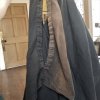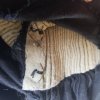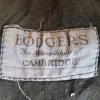Anna Evans
Registered Guest
Hello everyone,
I have an academic gown (possibly dating to the 60s- incidentally, I would be delighted if anyone has a better idea of the era. The label is Bodgers of Cambridge.)



Unfortunately, it has faded on one shoulder from sun. I would like to re-dye it black, but would like any input on the best way to go about this. I THINK it's cotton. I did a burn test with a stray thread and did not detect the 'burnt hair' odour. It smelt more like paper to me. There is a chance it may be a very fine wool, but my instinct is cotton. I have a packet of Dylon black machine dye, but I am hesitant to put a vintage item in a washing machine; particularly since it's pleated. I am not sure what padding the material is on the inside of the pleating. It is soft and fibrous.
I would be very grateful for any advice!

I have an academic gown (possibly dating to the 60s- incidentally, I would be delighted if anyone has a better idea of the era. The label is Bodgers of Cambridge.)

Unfortunately, it has faded on one shoulder from sun. I would like to re-dye it black, but would like any input on the best way to go about this. I THINK it's cotton. I did a burn test with a stray thread and did not detect the 'burnt hair' odour. It smelt more like paper to me. There is a chance it may be a very fine wool, but my instinct is cotton. I have a packet of Dylon black machine dye, but I am hesitant to put a vintage item in a washing machine; particularly since it's pleated. I am not sure what padding the material is on the inside of the pleating. It is soft and fibrous.
I would be very grateful for any advice!

Attachments
Last edited:
